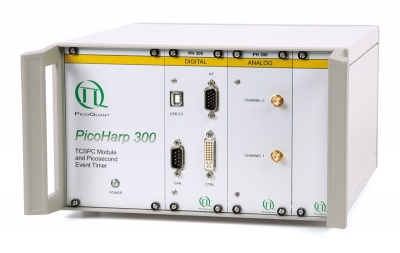June 22, 2009
New TCSPC System Software Version 2.3 for PicoHarp 300
New version includes a real-time correlator for Fluorescence Correlation Spectroscopy
 A new data acquisition software is now available for the PicoHarp 300 Time-Correlated Single Photon Counting system from PicoQuant. The new version 2.3 provides a new real-time correlator for Fluorescence Correlation Spectroscopy that calculates two autocorrelations and the cross correlation between two photon streams simultaneously, making best use of current multiprocessor systems. The new release also provides better support for online help under Windows Vista. It furthermore supports control for additional monochromator models, permitting the automated recording of Time-Resolved Emission Spectra (TRES).
A new data acquisition software is now available for the PicoHarp 300 Time-Correlated Single Photon Counting system from PicoQuant. The new version 2.3 provides a new real-time correlator for Fluorescence Correlation Spectroscopy that calculates two autocorrelations and the cross correlation between two photon streams simultaneously, making best use of current multiprocessor systems. The new release also provides better support for online help under Windows Vista. It furthermore supports control for additional monochromator models, permitting the automated recording of Time-Resolved Emission Spectra (TRES).
The PicoHarp is based on an entirely new time digitizer with 4 picoseconds resolution, a very short dead time, a processing rate of up to 10 million counts per second, and an extremely low differential non-linearity. It provides unique new features, notably two identical input channels that can operate independently, but with a common crystal time base. Therefore, not only classical TCSPC histograms for the measurement of fluorescence decays, but also picosecond coincidence correlations can be obtained. This is implemented using the instrument's Time-Tagged Time-Resolved (TTTR) mode, which records the picosecond arrival time of each individual photon. As a further improvement over the previous versions the new software now also supports correlations in the instrument's most advanced time tagging mode where both inputs are used as detector channels. The maximum measurement time has been extended to 100 hours so that photon-starved applications can be dealt with. For synchronization with other processes external markers can be recorded. This provides synchronization with virtually all existing imaging devices including laser scanning microscopes (LSM). Dedicated upgrade kits for widespread microscope models are available. Fluorescence lifetime images can be recorded with these systems at virtually any resolution and size. Fully software controlled Constant Fraction Discriminators (CFD) in all input channels ensure precise and optimized timing for a wide range of detectors. Optional accessories for signal conditioning, such as pre-amplifiers, attenuators and signal inverters allow the adaption to virtually all signal sources practically encountered in the lab. Sync/excitation sources can be as fast as 85 MHz but even very slow sources can be used efficiently with 'multi-stop' acquisition on the detector channel. The new software now provides warnings in situations where the measurement conditions are suboptimal or user settings are potentially erroneous, so that beginners are efficiently guided to avoid pitfalls. The PicoHarp system is designed as a USB 2.0 „Plug and Play device“, allowing control and data acquisition from a regular desktop computer or notebook PC. The USB interface is designed very efficiently, so that a sustained TTTR mode throughput of 5 millions of counts per second can be guaranteed for virtually any measurement time required. The new software is provided free of charge to all owners of a PicoHarp 300.
Downloads
Contact
General contact
Info request
info@picoquant.com
+49 (0)30 1208820-0
Press contact
Nicole Saritas
mkt@picoquant.com
+49 (0)30 1208820-0

